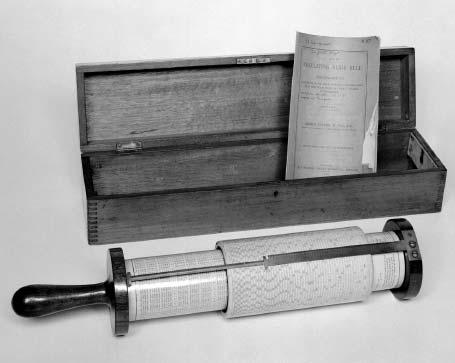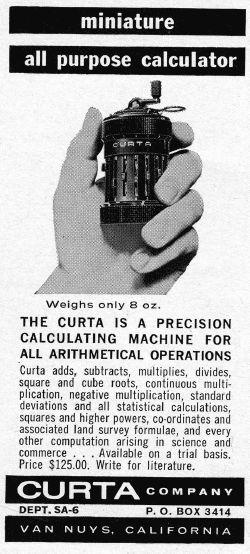Alex’s Adventures in Numberland (36 page)
Read Alex’s Adventures in Numberland Online
Authors: Alex Bellos

The oldest item in Peter Hopp’s collection was a wooden slide-rule from the early eighteenth century, used by taxmen for making calculations on alcohol volume. Before meeting Hopp, I had been sceptical as to how interesting slide-rule collecting could be as a pastime. At least stamps and fossils can be pretty! Slide-rules, on the other hand, are proudly functional tools of convenience. Hopp’s antique slide-rule, however, was beautiful, with elegantly crafted numbers on fine wood.
Hopp’s vast collection reflected the small improvements that were made over the centuries. In the nineteenth century new scales were added. Peter Roget – whose compulsive list-making (as a coping mechanism for mental illness) resulted in his timeless, classic, definitive
Thesaurus
– invented the log-log scale, which enabled calculation of fractions of powers, such as 3
2.5
, and square roots. As manufacturing techniques improved, new devices of increasing ingenuity, precision and splendour were designed. For instance, Thacher’s Calculating Instrument looks like a rolling pin on a metal mount, and Professor Fuller’s Calculator has three concentric, hollow brass cylinders and a mahogany handle. A 41ft-helix spirals around the cylinder, giving an accuracy of five significant figures. The Halden Calculex, on the other hand, looks like a timepiece and is made of glass and chromed steel. Slide-rules, I decided, are indeed objects of surprising appeal.

Professor Fuller’s Calculator.
Among these others, I spotted a contraption on Hopp’s shelf that looked like a pepper-grinder, and enquired what it was. He said it was a Curta. The Curta is a black, palm-sized cylinder with a crank handle on the top, and was a unique invention – the only mechanical pocket calculator ever produced. Demonstrating how it worked, Hopp cranked the handle round for one rotation, which reset the machine to zero. Numbers are input by adjusting knobs positioned on the Curta’s side. Hopp set the numbers to 346 and turned the handle once. He then reset the knobs to 217. When he turned the handle again, the sum of both numbers – 563 – was displayed on the top of the machine. Hopp said that the Curta could also subtract, multiply, divide and perform other mathematical operations. It used to be very popular with sports-car enthusiasts, he added. Navigators were able to calculate driving times by cranking it without taking their eyes off the road for too long. It was easier to read than a slide-rule, and less susceptible to bumps in the road.
Although the Curta is not a slide-rule, its ingeniousness at calculating has endeared it to collectors of mathematical instruments. Immediately upon using it, it was my favourite item in Hopp’s collection. For a start, it was a literal take on number-crunching – in went the numbers, and with a crank of the handle, the result appeared. The notion of grinding out an answer, however, was too crude a way to describe a gadget made up of 600 mechanical parts that moved with the precision of a Swiss watch.

Curta advert from 1971.
Even more intriguing, the Curta has a particularly dramatic history. Its inventor, Curt Herzstark designed the prototype for the device while a prisoner at the Buchenwald concentration camp during the final years of the Second World War. Herzstark, an Austrian whose father was Jewish, was given special dispensation to work on his calculating machine because he was known to the camp authorities as an engineering genius. Herzstark was told that if it worked, it would be given to Adolf Hitler as a present – after which he would be declared Aryan, and his life would be spared. When the end of the war came, and Herzstark was freed, he left with his nearly finished plans folded inside his pocket. After several attempts to find an investor, he eventually managed to convince the Prince of Liechtenstein – where the first Curta was manufactured in 1948. From then until the early 1970s, a factory in the principality produced about 150,000 of them. Herzstark lived in an apartment in Liechtenstein until he died, aged 86, in 1988.
Throughout the 1950s and the 1960s the Curta was the only pocket calculator in existence that could produce exact answers. But both the Curta and the slide-rule were all but rendered extinct by an event in the history of arithmetical paraphernalia as cataclysmic as the meteorite that is said to have annihilated the dinosaurs: the birth of the electronic pocket calculator.
It is hard to think of an object that has disappeared so quickly after such a long period of dominance than the slide-rule. For 300 years it reigned supreme until, in 1972, Hewlett-Packard launched the HP-35. The device was promoted as a ‘high precision portable electronic slide-rule’, but it wasn’t like a slide-rule at all. It was the size of a small book with a red LED display, 35 buttons, and an on-off switch. Within a few years it was impossible to buy a general-purpose slide-rule except second-hand, and the only people interested in them were collectors.
Even though the electronic calculator killed off his beloved slipstick, Peter Hopp bears no grudge. He likes to collect early electronic calculators too. When our conversation moved to them, he showed me his HP-35, and started reminiscing about the time he first saw one in the early 1970s. At the time, Hopp was beginning his career at Marconi, the electrical communications firm. One of his colleagues had bought an HP-35, which had cost him £365 – at the time, about half the annual salary of a junior engineer. ‘It was so valuable he kept it locked in his desk and never let anyone use it,’ Hopp said. The colleague, however, had another reason for his secrecy. He believed he had found a way of using the calculator that could save the company 1 percent of its expenditure. ‘He had top-secret meetings with the bosses. It was all hush, hush,’ said Hopp. In fact, though, his colleague had made a mistake. Calculators aren’t perfect instruments – type in 10 and divide by 3. You get 3.3333333. Multiply the result by 3, however, and you do not get back to where you started; rather, you get 9.9999999. Hopp’s colleague had used what was an anomaly in digital calculators to create something from nothing. Hopp recalled the incident with a smile: ‘When the plan was peer-reviewed by someone who used a slide-rule, the improvements were judged illusory.’
The story demonstrates why Hopp laments the demise of the slide-rule. The device provided the user with a visual understanding of numb which meant that even before he had worked out the answer he had a rough idea of what it would be. Nowadays, Hopp said, people plug numbers into a calculator without any intuitive sense of whether the answer is correct.
Still, the digital electronic calculator was an improvement on the analogue slide-rule. The pocket calculator was easier to use, gave precise answers and by 1978 was priced under £5, making it accessible to the general public.
It is now more than three decades since the slipstick slipped away, which means it is surprising to discover that there is, in fact, one situation in the modern world where they are still commonly used. Pilots use them to fly planes. A pilot’s slide-rule is circular, called a ‘whizz wheel’, and measures speed, distance, time, fuel consumption, temperature and air density. In order to qualify as a pilot, you must be proficient with a whizz wheel, which seems utterly strange, bearing in mind the high-end computer technology now used in cockpits. The slide-rule requirement is because pilots must also be able to fly small planes without onboard computers. Yet often pilots flying the most modern jets prefer to use their whizz wheels. Having a slide-rule at hand means you can work out estimates very quickly, and also have a more visual understanding of the numerical parameters of the flight. Flying jets is safer because of pilots’ dexterity with an early seventeenth-century calculating machine.
The astronomically high prices of the early electronic calculators made them luxury business products. The inventor Clive Sinclair called his first product the Executive. One marketing idea involved using geishas to target high-rolling businessmen in Japan. After a night of entertaining, the geisha would whip out a Sinclair Executive from under her kimono so that the host could add up the bill. He would then feel obliged to buy it.
As prices dropped, calculators were seen not only as arithmetical aides but also as versatile toys.
The Pocket Calculator Game Book
, published in 1975, suggested many recreational activities for the high-tech electronic marvel. ‘Pocket calculators are new to our lives. Unknown five years ago, they are becoming as popular as televisions or hi-fi sets,’ it said. ‘Yet they are different in that they are not a passive entertainment but require intelligent input and definite intention for their use. We are not so much interested in what the pocket calculator can do as we are in what you can do with your pocket calculator.’ In 1977 the bestselling
Fun & Games with Your Electronic Calculator
included a dictionary of words that can be made using only the letters O, I, Z, E, h, S, g, L and B, which are the LED digits and
and when turned upside-down. The longest words are:
when turned upside-down. The longest words are:
Seven letters:
OBELIZE
ELEgIZE
LIBELEE
OBLIgEE
gLOBOSE
SESSILE
LEgIBLE
BESIEgE
BIggISh
LEgLESS
ZOOgEOg
Eight letters:
ISOgLOSS
hEELLESS
EggShELL
Nine letters:
gEOLOgIZE
ILLEgIBLE
EISEgESIS
Surprisingly, the list does not include ‘BOOBLESS’ – the word whose use by teenage boys to their flat-chested female classmates is probably responsible for turning a generation of girls off mathematics. Still,
Fun & Games with Your Electronic Calculator
is probably the only numbers book that improves your English more than your arithmetic.
Enthusiasm for playing with one’s calculator was quickly extinguished as more enjoyable electronic games were introduced to the market. It soon became clear that instead of inspiring love of numbers, calculators would have the opposite effect – bringing about a decline in mental arithmetic skills.
